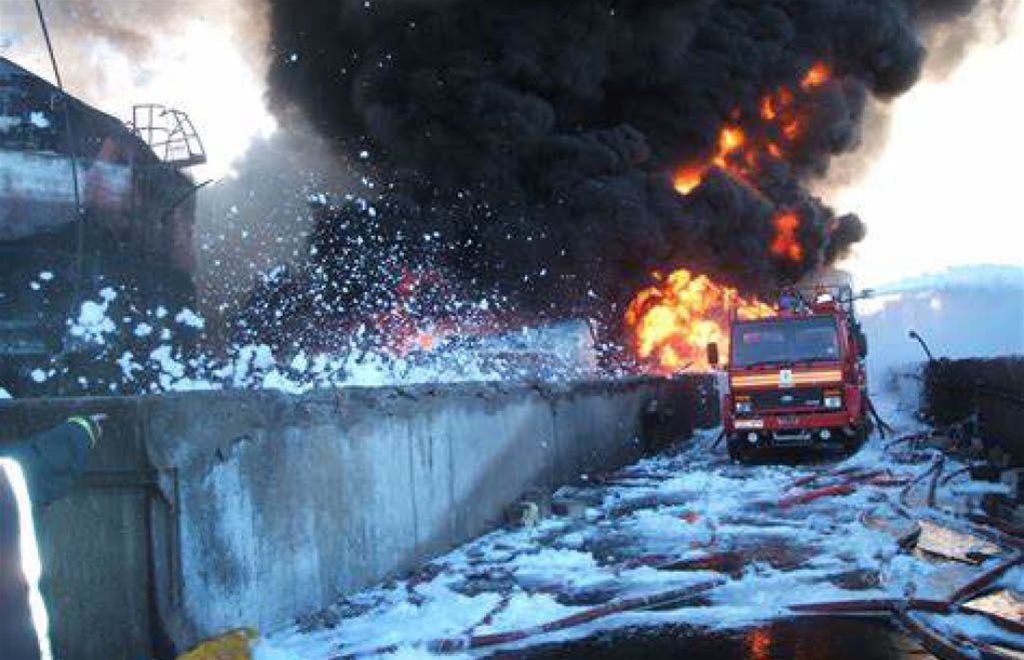The debate around the environmental impact of forever chemicals has stretched for decades. Here, Aisha Farooq examines the challenges ahead in the phasing out of PFAS substances for firefighting purposes.
The likelihood is that you have been exposed to them without even realising it. Think waterproof clothing, cosmetics, paint adhesives and sealants, cleaning products, non-stick cookware, bike oil, stain-resistant furniture, and even grease-proof takeaway packaging. All share one unique characteristic – they have been manufactured using ‘forever chemicals’.
The science behind the foam
Forever chemicals are, as their name suggests, seemingly everlasting. Put simply, they refer to per- and polyfluoroalkyl substances (PFAS). In the UK, three of these substances – PFOS, PFOA, and PFHxS – fall under the category of Persistent Organic Pollutants (POPs) and have seen greater regulation in recent years. PFAS substances are effective at repelling oil and water and, thus, useful for the common household objects listed earlier. But PFAS substances are also widely used in industrial applications, owing to their surfactant nature and making them ideal for foam control.
One popular industrial application is in the production of aqueous film-forming foams (AFFFs), used in firefighting foams to tackle flammable liquids or Class B fires. Perfect for scenarios where using water as a suppressant simply is not enough, they have played a huge part in combatting fires for decades.
In its guidance document, the National Fire Chiefs Council (NFCC) explains that the “foam ‘floats’ on the surface, creating a ‘blanket’ over the fuel surface and preventing flammable vapours from escaping. To do this,
the foam needs to be chemically strong and resilient. The foam concentrate can be made of hydrocarbon surfactants (detergents) or a blend of hydrocarbon and fluorinated surfactants.”
While PFAS has been in use in manufacturing industries for years, the precise fact that these substances are highly persistent and do not break down easily – if at all – has led to a cascade of growing concerns. In particular, long-chain PFAS, such as PFOA and PFOS chemicals, offer greater threats as they are considered to be persistent, bioaccumulative, and toxic, making them of environmental concern.
Studies as early as the 1990s showed the presence of small amounts of PFAS chemicals in the bloodstream of humans, as well as their presence in the environment. As their toxicity became widely realised, such chemicals
became inextricably linked to health hazards, including cancer, reproductive and developmental harms, and the reduced effectiveness of vaccines.
Since then, manufacturers have been looking to phase out the production of PFAS, specifically the more toxic PFOA and PFOS substances, in many household products. Environmental agencies have also stepped in, with some governments passing legislation to ban the use of these chemicals in industrial use, and enforcing the current procedure of containment, disposal, and replacement with less toxic alternatives.
Environmental concerns
The impact that these substances have on the environment is immense. As the Environment Agency (EA) outlines in its various literature on the subject: “Their stability and resistance to degradation results in almost indefinite environmental contamination, leading to long-term continuous exposure of people and wildlife.”
The primary concern is the pollution of underground water supplies from which drinking water is extracted. These are known as aquifers, and legal protection is afforded to these Source Protection Zones (SPZs). In the
event of a fire, the preferred approach might be to allow the building to ‘burn off’ rather than risk using water and/or foam that could make its way into the aquifer.
Initially, firefighting foams were manufactured using C8 fluorosurfactants, with both PFOS and PFOA classed as C8 PFAS. While PFOS foams are now completely banned, the process of phasing out PFOA foams has also begun. Short-chain C6 fluorosurfactants have now replaced the longer-chain chemicals in AFFF foams as they are deemed to be of lower toxicity, but concern around C6 PFAS foams is also beginning to grow. Recently, the EU announced a proposal to restrict its use (the UK has yet to come up with such a proposal), suggesting that we could see a future where PFAS might be phased out entirely if this becomes legislation.
But the key problem, as noted by the EA is that: “Even if sources of PFAS to the environment are stopped, environmental concentrations will decline very slowly. The long history of use of some PFAS means that there is a legacy of environmental contamination that is challenging to remediate.”
Lessons from Buncefield
The enduring nature of these chemicals cannot be underestimated. Many industry professionals will remember the colossal fire that broke out at an oil storage facility in Hemel Hempstead in December 2005. Later deemed to be the largest single-seat fire in the world ever to have been fought by a fire brigade, the Buncefield fire required a heroic effort to control the flammable liquid fuel flames, utilising foam supplies from sites across the UK.
The statistics tell us that 32,000 litres of firefighting foam were used per minute to quash the blaze. As a result, there were concerns about the potential pollution of local rivers and water sources, not just by the overflowing fuel that was stored at the facility, but also by possible fire water (that is, spent firefighting foam) making its way into the groundwater.
In 2006, Three Valleys Water announced that it had detected the presence of PFOS chemicals in a groundwater borehole close to the Buncefield site. The water supplier was keen to add, however, that it had not entered the public water supply. Hertfordshire Oil Storage Ltd later pleaded guilty to “causing pollution to enter controlled waters underlying the vicinity around the site, contrary to the Water Resources Act”. In 2010, the company was fined £1.45 million and another £1 million in costs.

Legislative phasing out
The government has banned the “manufacture, sale, and use of products containing POPs” unless specific exceptions are made, such as for firefighting purposes, specifically Class B fires. Legislation has also been put into place to restrict the wide use of firefighting foams containing these chemicals.
In a bid to raise awareness of the phasing out of the harmful chemicals found in AFFF foams alongside the UK POPs Regulations 2007, the EA published compliance advice for PFOA substances in Class B firefighting foams, which outlines the growing restrictions of firefighting foam use in real-world scenarios. As of 1 January 2023, the use of these firefighting foams is only allowed in sites where all releases can be contained. Notably, from 4 July 2025, all uses of these foams will be prohibited.
Speaking to F&RM, Joe Caddy, Advisor for the Chemicals Programme (Chemicals Regulatory Development Team) at the EA, and Martin Flack, Senior Advisor for the Chemicals Regulatory Development Team, highlighted the ongoing work being done by the EA and partner organisations to ensure POPs are no longer at risk of polluting the environment.
“The requirement is that if anyone is going to use a PFOA-containing foam, they have to contain all releases. If they don’t contain all releases and the foam does reach the environment, then potentially it will instigate an enforcement response from us, depending on what the incident is – we treat everything separately. We would look to carry out an appropriate, proportionate response to whatever that incident may be,” Joe explains.
Martin adds that the primary concern for the EA is “PFAS contamination of groundwater and, potentially, in potable water abstractions”.
“We’re doing quite a lot in the background to increase our understanding of PFAS in the environment,” he adds. Current guidance dictates that stockpiles of POP foams greater than 50kg must be notified with the EA. Additionally, unwanted PFOA firefighting foams must not be discharged into the sewer and should be disposed of using a registered waste carrier.
The EA is working with the HSE to produce a Regulatory Management Options Analysis or RMOA (expected to be published in Spring 2023): “The priority at the minute is trying to reduce discharges of PFOS and PFOA into ground and surface waters.”
The EA continues to engage with manufacturers of firefighting foams and the fire and rescue services (FRSs), and Martin notes that the most recent guidance prompted several questions from FRS about the disposal of PFOA foams, including when to register stockpiles of PFOA foams and about the decontamination of equipment.
“The challenge the fire service has is that with PFOA firefighting foams, from 1 January, they have to contain any runoff. They can’t allow discharges to the environment. For the fire service, that’s quite tricky. If you think about them attending road traffic accidents and things like that, it’s going to be very difficult for them to do that. My understanding is that many fire services have moved away from PFOA firefighting foams, and they’re not going to be using them in cases like that,” says Martin.

What are the alternatives?
The alternative is to consider fluorine-free substances that can be broken down more easily and do not leave a lasting impact on the environment. Leading foam manufacturers, such as Perimeter Solutions, have been exploring fluorine-free alternatives for many years.
Perimeter Solutions produces high-quality lubricant additives and firefighting chemicals and offers one of the most technologically advanced portfolios of Class B firefighting foam concentrates, which includes fluorine-free foams. Javier Castro, the Vice President/General Manager for Fire Safety Business at Perimeter Solutions, tells F&RM:
“Fluorine-free foams are not new and have been used in real scenarios for more than 15 years by different end users in North EU countries and Australia. The new technologies have continued to improve since being introduced, as has the level of performance. Programmes to evaluate the performance of the new technology in close to “real incidents” have been conducted by LASTFIRE on large surface fuel with gasoline, crude oil, ethanol, and other fuels, proving that fluorine-free foam is a viable solution.”
So, how does the efficiency of fluorine-free foams compare to legacy AFFF foams? Javier says that since fluorine-free foams were introduced to the market several years ago, “the performance gap with AFFF has been closed year by year, with increased acceleration over the last five years”.
“Currently, the performance of both products is very similar in a wide range of applications and fuels, which has accelerated transition to the new technology by a lot of end users.
“Fluorine-free foams now pass almost all international standards including EN-1568, UL, LastFire, IMO, etc. with the same ratio, applications, and proportioning rates as fluorinated products. In addition, programs run by end users have confirmed that fluorine-free foams are now a viable alternative.”
In a recently published RISCAuthority document, Migration of foam-enhanced fixed sprinkler and drencher systems to use fluorine-free alternatives, former Technical Director of the FPA, Professor James Glockling, outlined some of the major challenges the fire safety industry faces with fluorine-free foam solutions. Some of the challenges are around the “effectiveness” of such products, where higher concentrations of alternative products are needed, leading to similar, if not the same, environmental consequences.
“The challenge to remove fluorine from firefighting foams is not an easy one. Whilst fluorine-free foams might be termed as ‘eco’ or ‘environmentally friendly’, this might misrepresent them. Whether man-made or natural, they will have an impact on the environment and there will always be a need to consult the environmental protection authorities regarding their use, especially in areas where groundwater aquifers are the primary source of drinking water.
“In general, fluorine-free foams must currently be applied in much greater quantities, and for greater periods of time, to extinguish a fire when compared with AFFFs. While research is still being conducted, the greatest concern with fluorine-free foams (FFF or F3) is that they are not as effective or as fast at fire suppression as AFFF. For now, that means there’s no one-to-one alternative solution for many facilities, and those that can switch to fluorine-free firefighting foams will require some system upgrades or changes to accommodate the differing requirements of fluorine-free foams.”
There is also the necessity for replacement sprinkler systems that were initially manufactured based on legacy foams to handle the changed chemical makeup of fluorine-free foams:
“The candidate fluorine-free alternatives are currently less efficient, lacking the chemistry that supports the formation of a surfactant aqueous film over the fuel to seal in vapours. As such, they are more reliant upon the creation of a smothering foam layer, which may require a greater level of aspiration at the nozzle than some sprinkler and drencher systems might be able to provide without significant system redesign and component change. This raises some great challenges for the design and certification of sprinkler and drencher systems where, formerly, the augmentation with foam required only the addition of the dosing mechanism when using foam in a non-aspirated form.”
Javier agrees that the compatibility of these products is a key concern: “The main concerns we have heard from end users are related to compatibility of the products with their equipment, self-life, and how to run the transition.”
But Javier is certain that fluorine-free alternatives can live up to the efficacy that is expected of them: “Manufacturers are investing a lot of their resources in R&D in order to make this transition successful and to continue to protect lives and properties. R&D efforts on the product development side should continue, as should responding to end users’ concerns or special requirements. Manufacturers should also support the industry and regulators on different programmes and testing to continue to gain knowledge of the performance of fluorine-free foam and address any gaps to improve and accelerate product development.”

Weighing up the risk
Prior to the phasing out of PFAS substances in firefighting foams, the NFCC was keen to reiterate that the risks associated with firefighting foams and other firefighting additives “should not deter the use of foam at incidents where there is a need… In some cases, this can include protection of the environment if, for example, foam is likely to result in the fire being extinguished more quickly than using water alone.”
Until now, this has been widely agreed upon, but the very real dangers of forever chemicals on the environment cannot be ignored. Regardless of the effectiveness and potential problems of the fluorine-free alternatives, it is clear we no longer have a choice in the matter.
You can access the EA guidance on the disposal and storage of Class B foams here.
Fire & Risk Management is the UK’s market leading fire safety journal, published 10 times a year, and is available exclusively to FPA members in digital and print format depending on your requirements. You can find out more about our membership scheme here.
Aisha Farooq is the Assistant Editor of the Fire & Risk Management journal.